华为S2700 S3700系列交换机 01-02 以太网接口配置
华为S2700 S3700系列交换机 01-11 策略路由配置
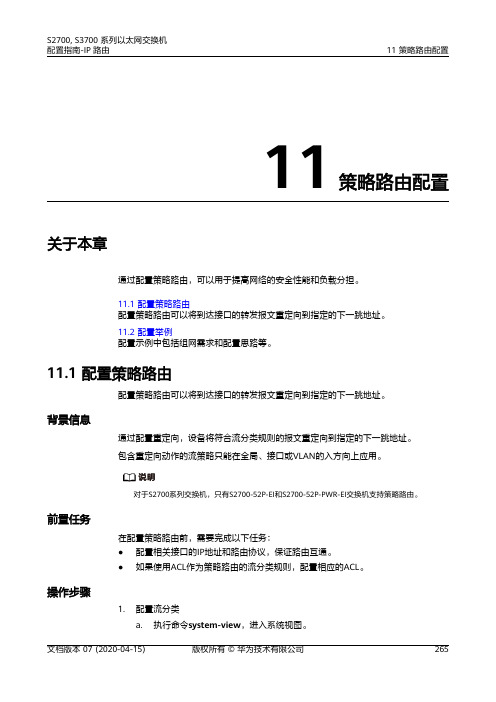
11策略路由配置关于本章通过配置策略路由,可以用于提高网络的安全性能和负载分担。
11.1 配置策略路由配置策略路由可以将到达接口的转发报文重定向到指定的下一跳地址。
11.2 配置举例配置示例中包括组网需求和配置思路等。
11.1 配置策略路由配置策略路由可以将到达接口的转发报文重定向到指定的下一跳地址。
背景信息通过配置重定向,设备将符合流分类规则的报文重定向到指定的下一跳地址。
包含重定向动作的流策略只能在全局、接口或VLAN的入方向上应用。
说明对于S2700系列交换机,只有S2700-52P-EI和S2700-52P-PWR-EI交换机支持策略路由。
前置任务在配置策略路由前,需要完成以下任务:●配置相关接口的IP地址和路由协议,保证路由互通。
●如果使用ACL作为策略路由的流分类规则,配置相应的ACL。
操作步骤1.配置流分类a.执行命令system-view,进入系统视图。
b.执行命令traffic classifier classifier-name [ operator { and | or } ],创建一个流分类并进入流分类视图,或进入已存在的流分类视图。
and表示流分类中各规则之间关系为“逻辑与”,指定该逻辑关系后:▪当流分类中有ACL规则时,报文必须匹配其中一条ACL规则以及所有非ACL规则才属于该类;▪当流分类中没有ACL规则时,则报文必须匹配所有非ACL规则才属于该类。
or表示流分类各规则之间是“逻辑或”,即报文只需匹配流分类中的一个或多个规则即属于该类。
缺省情况下,流分类中各规则之间的关系为“逻辑与”。
c.请根据实际情况定义流分类中的匹配规则。
d.执行命令quit,退出流分类视图。
2.配置流行为a.执行命令traffic behavior behavior-name,创建一个流行为,进入流行为视图。
b.请根据实际需要进行如下配置:▪执行命令redirect ip-nexthop ip-address &<1-4> [ forced ],将符合流分类的报文重定向到下一跳。
华为S2700 S3700系列 01-01 接口基础配置
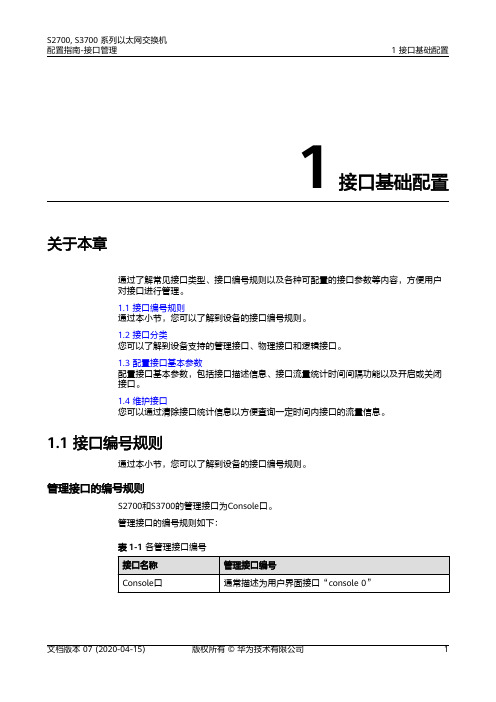
文档版本 07 (2020-04-15)
版权所有 © 华为技术有限公司
7
背景信息
对接口进行基本配置前,需要进入接口视图。
操作步骤
步骤1 执行命令system-view,进入系统视图。 步骤2 执行命令interface interface-type interface-number,进入接口视图。
其中,interface-type为接口类型,interface-number为接口编号。
3
S2700, S3700 系列以太网交换机 配置指南-接口管理
接口类型 NULL接口
1 接口基础配置
描述 因为任何送到该接口的网络数据报文都会被丢弃,主要用 于路由过滤等特性。
1.3 配置接口基本参数
配置接口基本参数,包括接口描述信息、接口流量统计时间间隔功能以及开启或关闭 接口。
1.3.1 进入接口视图
表 1-2 物理接口编号规则
接口编排规则示意图
2 4 6 ... ...
1 3 5 ...
说明
设备有两排业务接口,左下接口从1起 始编号,依据从下到上,再从左到右 的规则依次递增编号。 例如,左上第一个接口编号为0/0/2。
1.2 接口分类
您可以了解到设备支持的管理接口、物理接口和逻辑接口。
接口是设备与网络中的其它设备交换数据并相互作用的部件,分为管理接口、物理业 务接口和逻辑接口三类,其中:
1.3 配置接口基本参数 配置接口基本参数,包括接口描述信息、接口流量统计时间间隔功能以及开启或关闭 接口。
1.4 维护接口 您可以通过清除接口统计信息以方便查询一定时间内接口的流量信息。
1.1 接口编号规则
通过本小节,您可以了解到设备的接口编号规则。
01-02 常见查看设备状态操作

2常见查看设备状态操作关于本章介绍查看设备状态的常见操作。
2.1 查看设备的序列号2.2 查看设备的补丁信息2.3 查看设备的版本信息2.1 查看设备的序列号每台设备的序列号ESN(Equipment Serial Number)是唯一的。
当用户需要设备售后服务或者申请License时,都需要提供设备的序列号。
# 执行命令display esn查看设备的序列号。
下面显示以框式为例,盒式显示请以设备为准。
<HUAWEI> display esnESN of master:7700060123456789ESN of slave:7700060123456789盒式S1720GFR、S2750EI、S5700LI、S5700S-LI和S5710–X-LI不支持此命令,框式和盒式的其他款型都支持该命令。
2.2 查看设备的补丁信息# 执行命令display patch-information查看当前设备的补丁信息。
下面显示以框式为例,盒式显示请以设备为准。
<HUAWEI> display patch-informationPatch Package Name :cfcard:/patch.patPatch Package Version:V200R008C00SPH001The state of the patch state file is: RunningThe current state is: Running************************************************************************* Information about hot patch errors is as follows: *************************************************************************Slot CurrentVersion------------------------------------------------------------No hot patch error occurs on any board.************************************************************************* The hot patch information, as follows: *************************************************************************Slot Type State Count Time(YYYY-MM-DD HH:MM:SS)------------------------------------------------------------------------14 C Running 1 2012-08-15 09:20:48+00:002.3 查看设备的版本信息# 执行命令display version查看当前设备的版本信息。
华为S2700 S3700系列交换机 01-13 IP语音接入配置

13 IP 语音接入配置
组网需求
网络中有HSI、VoIP和IPTV等各种流量,用户对语音通话质量较敏感,需要提高语音数 据流的传输优先级,以保证用户的通话质量。如果语音设备支持DHCP协议,默认 8021p的优先级比较高(比如8021p的优先级为5)。可以在交换机上启用DHCP功能 实现IP语音接入,交换机通过DHCP协议给语音设备分配VLAN ID,不修改其报文中 VLAN优先级。
1. 创建VLAN。 2. 配置接口类型及缺省VLAN。 3. 配置接口信任报文的802.1p值 4. 使能地址池。 5. 配置地址池中的option选项。 6. 全局DHCP使能,通过DHCP分配IP地址。
操作步骤
步骤1 配置Switch的VLAN和接口
# 创建VLAN2、VLAN6
<Quidway> system-view [Quidway] vlan batch 2 6
-----------------------------------------------------------
Port
Add-Mode Security-Mode Legacy
-----------------------------------------------------------
13.2 配置举例
13.2.1 配置通过 LLDP 实现 IP 语音接入交换机
文档版本 08 (2020-04-15)
版权所有 © 华为技术有限公司
315
S2700, S3700 系列以太网交换机 配置指南-以太网
13 IP 语音接入配置
组网需求
网络中有HSI、VoIP和IPTV等各种流量,用户对语音通话质量较敏感,需要提高语音数 据流的传输优先级,以保证用户的通话质量。如果语音设备支持LLDP协议,默认 8021p的优先级比较高(比如8021p的优先级为5)。可以在交换机上启用LLDP和 VOICE VLAN功能实现IP语音接入,交换机通过LLDP协议给语音设备分配VLAN ID,不 修改其报文中VLAN优先级。
华为交换机 01-02 首次登录系统
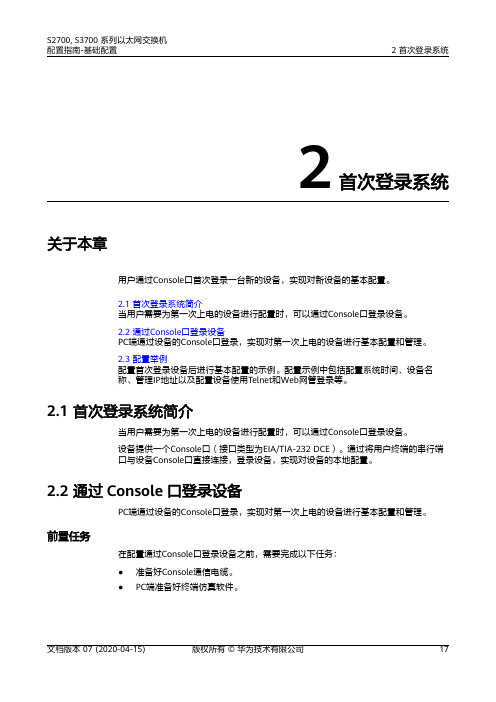
Please configure the login password (6-16) Enter Password: Confirm Password:
说明
– 如果设备出厂时已有初始密码,请输入初始密码“Admin@”进入系统, 但此密码不是安全密码,请及时修改,修改方法请参见3.2.4 配置Console用户界面的 用户验证方式。
----结束
2.3 配置举例
配置首次登录设备后进行基本配置的示例。配置示例中包括配置系统时间、设备名 称、管理IP地址以及配置设备使用Telnet和Web网管登录等。
2.3.1 配置首次登录设备后进行基本配置的示例
组网需求
通过Console口首次登录设备后,对设备进行基本配置并配置通过Telnet远程登录的0 ~4号用户的级别为15级,认证方式为AAA认证。
表 2-5 配置 Web 网管登录
操作
命令
进入系统视图
system-view
加载Web网页文件
http server load filename
说明
-
设备在出厂时存储设备 中已经保存了WEB网页 文件,名称为:产品-软 件版本号.WEB网管文件 版本号.web.zip。
文档版本况下,设备会默认创建初始用户,用户名和密码分别为admin、 admin@。Web网管的详细配置请参见4 配置用户登录中的Web网管 配置部分。
5. 保存配置
完成基本配置后,建议保存配置,以防配置信息丢失导致需重新进行首次登录的 连接和配置。
表 2-6 保存配置 操作
退出至用户视图 保存配置
配置接口的 ip address ip-address { mask
华为S2700 S3700系列交换机 01-02 VLAN配置
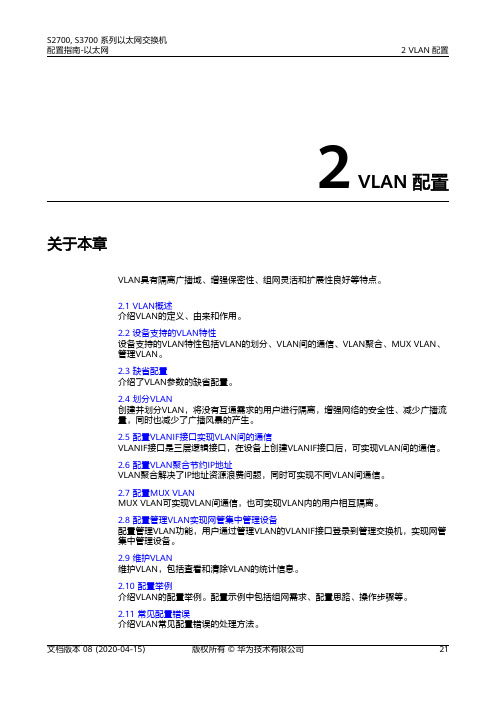
2 VLAN配置关于本章VLAN具有隔离广播域、增强保密性、组网灵活和扩展性良好等特点。
2.1 VLAN概述介绍VLAN的定义、由来和作用。
2.2 设备支持的VLAN特性设备支持的VLAN特性包括VLAN的划分、VLAN间的通信、VLAN聚合、MUX VLAN、管理VLAN。
2.3 缺省配置介绍了VLAN参数的缺省配置。
2.4 划分VLAN创建并划分VLAN,将没有互通需求的用户进行隔离,增强网络的安全性、减少广播流量,同时也减少了广播风暴的产生。
2.5 配置VLANIF接口实现VLAN间的通信VLANIF接口是三层逻辑接口,在设备上创建VLANIF接口后,可实现VLAN间的通信。
2.6 配置VLAN聚合节约IP地址VLAN聚合解决了IP地址资源浪费问题,同时可实现不同VLAN间通信。
2.7 配置MUX VLANMUX VLAN可实现VLAN间通信,也可实现VLAN内的用户相互隔离。
2.8 配置管理VLAN实现网管集中管理设备配置管理VLAN功能,用户通过管理VLAN的VLANIF接口登录到管理交换机,实现网管集中管理设备。
2.9 维护VLAN维护VLAN,包括查看和清除VLAN的统计信息。
2.10 配置举例介绍VLAN的配置举例。
配置示例中包括组网需求、配置思路、操作步骤等。
2.11 常见配置错误介绍VLAN常见配置错误的处理方法。
2.1 VLAN概述介绍VLAN的定义、由来和作用。
VLAN(Virtual Local Area Network)即虚拟局域网,是将一个物理的LAN在逻辑上划分成多个广播域的通信技术。
以太网是一种基于CSMA/CD(Carrier Sense Multiple Access/Collision Detection)的共享通讯介质的数据网络通讯技术。
当主机数目较多时会导致冲突严重、广播泛滥、性能显著下降甚至造成网络不可用等问题。
通过交换机实现LAN(Local AreaNetwork)互连虽然可以解决冲突严重的问题,但仍然不能隔离广播报文和提升网络质量。
华为S2700 S3700系列 01-01 以太网链路聚合配置

1以太网链路聚合配置关于本章链路聚合是将多条以太网链路捆绑在一起成为一条逻辑链路。
通过配置链路聚合,可以实现增加带宽、提高可靠性、负载分担的目的。
1.1 链路聚合概述介绍链路聚合的定义、由来和作用。
1.2 设备支持的链路聚合特性设备支持手工负载分担和LACP(Link Aggregation Control Protocol)两种链路聚合模式。
1.3 缺省配置介绍了链路聚合参数的缺省配置。
1.4 配置手工负载分担模式链路聚合通过配置链路聚合,可以达到负载分担、增加带宽、提高可靠性的目的。
1.5 配置LACP模式链路聚合通过配置链路聚合,可以达到负载分担、增加带宽、提高可靠性的目的。
1.6 维护链路聚合维护链路聚合,包括监控链路聚合运行情况和清除LACP统计信息。
1.7 配置举例介绍链路聚合的配置举例。
配置示例中包括组网需求、配置思路、操作步骤等。
1.8 常见配置错误介绍链路聚合常见配置错误的处理方法。
1.1 链路聚合概述介绍链路聚合的定义、由来和作用。
链路聚合(Link Aggregation)是将—组物理接口捆绑在一起作为一个逻辑接口来增加带宽和可靠性的一种方法。
链路聚合组LAG(Link Aggregation Group)是指将若干条以太链路捆绑在一起所形成的逻辑链路,简写为Eth-Trunk。
随着网络规模不断扩大,用户对链路的带宽和可靠性提出越来越高的要求。
在传统技术中,常用更换高速率的接口板或更换支持高速率接口板的设备的方式来增加带宽,但这种方案需要付出高额的费用,而且不够灵活。
采用链路聚合技术可以在不进行硬件升级的条件下,通过将多个物理接口捆绑为一个逻辑接口,实现增加链路带宽的目的。
链路聚合的备份机制能有效提高可靠性,同时,还可以实现流量在不同物理链路上的负载分担。
如图1-1所示,DeviceA与DeviceB之间通过三条以太网物理链路相连,将这三条链路捆绑在一起,就成为了一条Eth-Trunk逻辑链路,这条逻辑链路的带宽等于原先三条以太网物理链路的带宽总和,从而达到了增加链路带宽的目的;同时,这三条以太网物理链路相互备份,有效地提高了链路的可靠性。
华为S2700 S3700系列交换机 01-08 CFM配置

8.4.3 创建维护域 MD
背景信息
在所有需要实施以太网CFM管理的设备上进行以下配置。
操作步骤
步骤1 执行命令system-view,进入系统视图。
步骤2 执行命令cfm md md-name [ format { no-md-name | dnsname-and-mdname | mac-address | md-name } ] [ level level ],创建MD并进入MD视图。
根据网络的分层/分级架构,需要提供分层/分级的以太OAM功能。如图8-1所示。
图 8-1 以太网 OAM 示意图 Services Access
Metro
CE
PE1
P
PE2
PE3
Core
Access Link OAM
Connectivity Layer OAM
Service Layer OAM
EFM
缺省情况下,设备的全局CFM功能处于未使能状态。 ----结束
8.4.2 版本切换
背景信息
缺省情况下,设备启用的是802.1ag协议draft7草案版本。如果需要使用standard2007 标准版本,在所有需要切换版本的设备上进行system-view,进入系统视图。 步骤2 执行命令cfm version { draft7 | standard },切换版本。
8 CFM 配置
组网类别 映射原则
端到端链路
当MA部署在端到端组网中时如MA2,需要MA与业务实例关联。但是 不同的网络层次,维护集MA与业务实例的关联方式不同。如图8-2所 示:
华为交换机 以太网接口典型配置

不支 持
支 40GE光接口插上高速电 持 缆后,当用户执行命令
display interface,查看 接口当前运行状态和接口 统计信息时,自协商功能 显示为使能状态,但是系 统不支持使用命令 negotiation auto,配置其 自协商模式。
文档版本 13 (2017-01-10)
网线
FE电接口 网线
100
全
双
工/
半
双
工
1000
全
双
工
2500
全
双
工
10
全
双
工/
半
双
工
自 备注 协 商 模 式 支 仅S5720-14X-PWH-SI持 AC支持MultiGE口。
MultiGE口仅支持在自协 商模式下配置接口速率为 100,配置双工模式为半 双工。
支持
文档版本 13 (2017-01-10)
//缺省情况下,Combo接口工作模式为auto,修改为电
步骤2
验证配置结果
在任意视图下执行命令display interface gigabitethernet 1/0/4,检查Combo接口工作模 式。
[Switch] display interface gigabitethernet 1/0/4 ... Port Mode: FORCE COPPER Speed : 1000, Loopback: NONE Duplex: FULL, Negotiation: ENABLE Mdi : AUTO, Flow-control: DISABLE ...
文档版本 13 (2017-01-10)
华为专有和保密信息
华为S2700 S3700系列交换机 01-09 监控口配置

9监控口配置关于本章通过配置监控口,可以实现对设备的使用环境进行监控,方便管理员对设备进行维护。
9.1 监控口简介介绍监控口的定义和目的。
9.2 配置注意事项介绍监控口特性的注意事项及设备支持的监控口。
9.3 配置监控口介绍监控口的详细配置过程。
9.4 配置举例介绍监控口配置举例。
配置示例中包括组网需求、配置思路等。
9.1 监控口简介介绍监控口的定义和目的。
定义监控口是位于设备上用于监控机柜门、设备电源、电池电量和空调电源等设备的接口。
目的在某些应用场景中,如交换机部署在接入侧作为楼道交换机实现宽带用户接入,因为楼道应用环境的特殊性,交换机需要安装在定制的机箱内,机箱内配置了备用电源。
由于这些设备与网络管理员所在的中心机房距离较远,当这些设备发生故障时,由于设备无法主动上报故障,导致网络管理员无法及时感知。
为了解决这个问题,交换机提供了环境监控接口,连接机柜门、备用电源等设备,当机箱门、备用电源等设备应用状况异常时,交换机发送Trap至网管站,实现对交换机应用环境的监控。
图9-1监控口应用示意图机柜门备用电源电池电量空调电源9.2 配置注意事项介绍监控口特性的注意事项及设备支持的监控口。
监控口特性的注意事项只有S3700-28TP-EI-MC支持此特性。
设备支持的监控口设备提供两个监控口,一个为监控输入口,另外一个为监控输出口。
●监控输入口:监控输入口为普通的以太网接口,提供4条输入线路,用来监控4种不同的源,例如机柜门、设备电源、电池电量和空调电源等设备(具体监控的设备由用户决定,可以监控但不限于上述设备)。
以直通网线为例,如图9-2所示,线序为:橙白、橙、绿白、蓝、蓝白、绿、褐白、褐。
每两根线为一路输入线路,这样依次橙白、橙为1号输入线路;绿白、绿为2号输入线路;蓝白、蓝为3号输入线路;褐白、褐为4号输入线路。
橙白、绿白、蓝白、褐白线要求连接到被监控设备的一个电平可变的端子上,被监控设备状态变化时,该端子的电平会由高变低或由低变高。
华为交换机的配置S2700
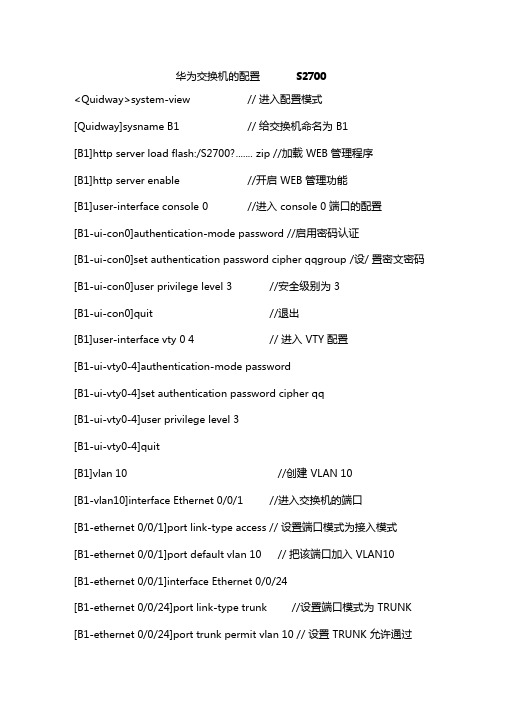
华为交换机的配置S2700<Quidway>system-view // 进入配置模式[Quidway]sysname B1 // 给交换机命名为B1[B1]http server load flash:/S2700? ....... zip //加载WEB 管理程序[B1]http server enable //开启WEB 管理功能[B1]user-interface console 0 //进入console 0 端口的配置[B1-ui-con0]authentication-mode password //启用密码认证[B1-ui-con0]set authentication password cipher qqgroup /设/ 置密文密码[B1-ui-con0]user privilege level 3 //安全级别为3[B1-ui-con0]quit //退出[B1]user-interface vty 0 4 // 进入VTY 配置[B1-ui-vty0-4]authentication-mode password[B1-ui-vty0-4]set authentication password cipher qq[B1-ui-vty0-4]user privilege level 3[B1-ui-vty0-4]quit[B1]vlan 10 //创建VLAN 10[B1-vlan10]interface Ethernet 0/0/1 //进入交换机的端口[B1-ethernet 0/0/1]port link-type access // 设置端口模式为接入模式[B1-ethernet 0/0/1]port default vlan 10 // 把该端口加入VLAN10[B1-ethernet 0/0/1]interface Ethernet 0/0/24[B1-ethernet 0/0/24]port link-type trunk //设置端口模式为TRUNK [B1-ethernet 0/0/24]port trunk permit vlan 10 // 设置TRUNK 允许通过的VLAN[B1-ethernet 0/0/24]quit [B1]interface vlan 10 [B1]ip add 192.168.10.1 24 [B1]quit<B1>save//进入VLAN 接口//给VLAN 配置管理地址。
华为S2700系列企业交换机产品介绍说明书
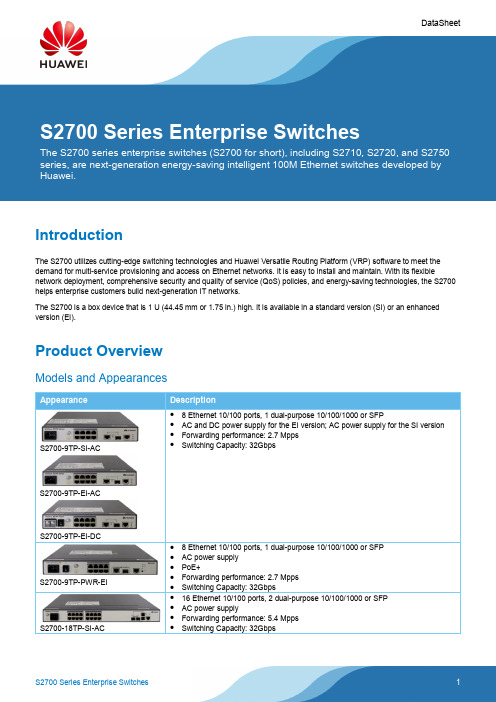
DataSheetIntroductionThe S2700 utilizes cutting-edge switching technologies and Huawei Versatile Routing Platform (VRP) software to meet the demand for multi-service provisioning and access on Ethernet networks. It is easy to install and maintain. With its flexiblenetwork deployment, comprehensive security and quality of service (QoS) policies, and energy-saving technologies, the S2700 helps enterprise customers build next-generation IT networks.The S2700 is a box device that is 1 U (44.45 mm or 1.75 in.) high. It is available in a standard version (SI) or an enhanced version (EI).Product OverviewModels and AppearancesAppearanceDescriptionS2700-9TP-SI-ACS2700-9TP-EI-ACS2700-9TP-EI-DC● 8 Ethernet 10/100 ports, 1 dual-purpose 10/100/1000 or SFP●AC and DC power supply for the EI version; AC power supply for the SI version ● Forwarding performance: 2.7 Mpps ●Switching Capacity: 32GbpsS2700-9TP-PWR-EI● 8 Ethernet 10/100 ports, 1 dual-purpose 10/100/1000 or SFP ● AC power supply ●PoE+● Forwarding performance: 2.7 Mpps ● Switching Capacity: 32GbpsS2700-18TP-SI-AC● 16 Ethernet 10/100 ports, 2 dual-purpose 10/100/1000 or SFP ●AC power supply● Forwarding performance: 5.4 Mpps ●Switching Capacity: 32GbpsS2700-18TP-EI-ACS2700-26TP-SI-ACS2700-26TP-EI-AC● 24 Ethernet 10/100 ports, 2 dual-purpose 10/100/1000 or SFP●AC power supply for the EI version; AC power supply for the SI version ● Forwarding performance: 6.6 Mpps ●Switching Capacity: 32GbpsS2700-26TP-PWR-EI● 24 Ethernet 10/100 ports, 2 dual-purpose 10/100/1000 or SFP ● AC power supply ●PoE+● Forwarding performance: 6.6 Mpps ● Switching Capacity: 32GbpsS2710-52P-SI-AC●48 Ethernet 10/100 ports, 4 Gig SFP ● AC power supply● Forwarding performance: 13.2 Mpps ● Switching Capacity: 32GbpsS2700-52P-EI-AC● 48 Ethernet 10/100 ports, 4 Gig SFP ●AC and DC power supply● Forwarding performance: 13.2 Mpps ● Switching Capacity: 32GbpsS2700-52P-PWR-EI● 48 Ethernet 10/100 ports, 4 Gig SFP ●AC power supply ● PoE+● Forwarding performance: 13.2 Mpps ● Switching Capacity: 32GbpsS2750-20TP-PWR-EI-AC● 16 Ethernet 10/100 ports, 2 Gig SFP and 2 dual-purpose 10/100/1000 or SFP ●AC power supply ● PoE+● Forwarding performance: 8.4 Mpps ● Switching Capacity: 64GbpsS2750-28TP-EI-AC●24 Ethernet 10/100 ports, 2 Gig SFP and 2 dual-purpose 10/100/1000 or SFP ● AC power supply● Forwarding performance: 9.6 Mpps ● Switching Capacity: 64GbpsS2750-28TP-PWR-EI-AC● 24 Ethernet 10/100 ports, 2 Gig SFP and 2 dual-purpose 10/100/1000 or SFP ●AC power supply ● PoE+● Forwarding performance: 9.6 Mpps ● Switching Capacity: 64GbpsS2720-28TP-EI-AC●24 Ethernet 10/100 ports,2 Gig SFP and 2 dual-purpose ● 10/100/1000 or SFP ● AC power supply● Forwarding performance: 9.6 Mpps ●Switching Capacity: 12.8GbpsFan TrayS2700 uses a new generation of high integrated chip and energy-saving circuit design, balanced heat, low power consumption, no fan of mute design.Power SupplyS2700 non-PoE model do not support pluggable power supplies.PoE/PoE+PWR in the model name indicates a PoE-capable switch, which supports IEEE 802.3af-compliant PoE and 802.3at-compliant PoE+. Each port delivers 15.4 W PoE or 30 W PoE+ power capacity.PoE power is divided into two types: 500W and 250W power supplies.S2700-9TP-PWR-EI Built-in single powersupply - 124 W PoE (15.4W): 8PoE+ (30W): 4S2700-26TP-PWR-EI W0PSA2500 - 123.2 W PoE (15.4W): 8PoE+ (30W): 4W0PSA5000 - 369.6W PoE (15.4W): 24PoE+ (30W): 12W0PSA2500 W0PSA2500 246.4W PoE (15.4W): 16PoE+ (30W): 8W0PSA5000 W0PSA5000 739.2W PoE (15.4W): 24PoE+ (30W): 24 S2700-52P-PWR-EI W0PSA2500 - 123.2 W PoE (15.4W): 8PoE+ (30W): 4W0PSA5000 - 369.6W PoE (15.4W): 24PoE+ (30W): 12W0PSA2500 W0PSA2500 246.4W PoE (15.4W): 16PoE+ (30W): 8W0PSA5000 W0PSA5000 739.2W PoE (15.4W): 48PoE+ (30W): 24S2750-20TP-PWR-EI-AC Built-in single powersupply - 370W PoE (15.4W): 16PoE+ (30W): 12S2750-28TP-PWR-EI-AC Built-in single powersupply - 370W PoE (15.4W): 24PoE+ (30W): 12When a switch has two power supplies installed, the two power supplies work in redundancy mode to provide power for the switch itself and in load balancing mode to provide power for powered devices (PDs).Product Features and HighlightsEasy Operation●The S2700 supports Huawei Easy Operation function. Thanks to this function, the S2700 implements easy installation, configuration, monitoring, and troubleshooting, greatly reduces initial installation and configuration costs, improves upgrade efficiency and lowers engineering costs. It provides a Web network management system (NMS) with a user-friendly graphical user interface (GUI) to implement alarm management and visual configuration, facilitating operation and maintenance. In addition, it supports faulty device replacement without configuration.●The S2700 offers a new application-specific integrated circuit (ASIC) switching technique and a fan-free design. This design reduces mechanical faults and protects the device against damages caused by condensed water and dust. Flexible service control●The S2700-EI supports various ACLs. ACL rules can be applied to VLANs to flexibly control ports and schedule VLAN resources.●The S2700 supports port-based VLAN assignment, MAC address-based VLAN assignment, protocol-based VLAN assignment, and network segment-based VLAN assignment. These secure and flexible VLAN assignment modes are used in networks where users move frequently.●The S2700 supports GARP VLAN Registration Protocol (GVRP), which dynamically distributes, registers, and propagates VLAN attributes to ensure correct VLAN configuration and reduce network administrator workloads. In addition, the S2700 supports SSH v2, HWTACACS, RMON, and port-based traffic statistics. The network quality analyzing (NQA) function assists users with network planning and upgrades.Excellent security features●The S2700 supports DHCP snooping, which generates user binding entries based on users' access interfaces, MAC addresses, IP addresses, IP address leases, VLAN IDs. The DHCP snooping function protects enterprises from common attacks such as bogus IP packet attacks, man-in-the-middle attacks, and bogus DHCP server attacks.●The S2700 can limit the number of MAC addresses that can be learned on an interface to prevent attackers from exhausting MAC address entries by using bogus source MAC addresses. This function minimizes packet flooding, which occurs when users' MAC addresses cannot be found in the MAC address table. The S2700 can also limit the number of ARP entries to prevent ARP spoofing attacks. In addition, it provides an IP source check function to prevent malicious users from using spoofed IP addresses to initiate DoS attacks.●The S2700 supports centralized MAC address authentication and 802.1x authentication. It authenticates users based on statically or dynamically bound user information such as IP address, MAC address, VLAN ID, access interface. VLANs, QoS policies, and ACLs can be dynamically applied to users.PoE function●The S2700 PWR series support improved Power over Ethernet (PoE) solutions and you can determine whether a PoE port provides power and the time a PoE port provides power. The S2700 PWR can use PoE power supplies with different power levels to provide the PoE function. Powered devices (PDs) such as IP Phones, WLAN APs, and Bluetooth APs can be connected to the S2700 PWR through network cables. The S2700 PWR provides -48V DC power for the PDs.●In its role as power sourcing equipment (PSE), the S2700 PWR complies with IEEE 802.3af and 802.3at (PoE+), and can work with PDs that are incompatible with 802.3af or 802.3at (PoE+). Each port provides a maximum of 30 W of power, complying with IEEE 802.3at. The PoE+ function increases the maximum power available on each port and implements intelligent power management for high-power consumption applications. This process facilitates the ease of PD use. PoE ports are still able to work while in power-saving mode.High scalability●The S2700 uses Intelligent Stack (iStack) to virtualize multiple switches into a single logical device to ease user management and configuration and expand the system switching capacity. iStack improves switching capacity, reliability, and scalability. Additionally, after the stack is established, all the member switches in a stack use the same IP address. You can use a single IP address to manage and maintain the switches uniformly. This greatly reduces system operation and maintenance (O&M) costs.●The iStack stacking architecture is designed for rapid failover capability with n-1 master redundancy, distributed Layer 2 and Layer 3 switching, link aggregation across the stack, and within 200 millisecond failover for path failure and hitlessmaster/backup failover.●Besides traditional STP, RSTP, and MSTP, the S2700 supports enhanced Ethernet technologies such as Smart Link and RRPP, implements millisecond-level protection switchover for links, and ensures the network quality.●The S2700 supports Smart Ethernet Protection (SEP) protocol, a ring network protocol applied to the link layer of an Ethernet network. SEP provides millisecond-level service switchovers and ensures nonstop forwarding of services. In addition, SEP features simplicity, high reliability, high switchover performance, convenient maintenance, and flexible topology and enables users to manage and plan networks conveniently.●The S2700 supports G.8032 Ethernet Ring Protection Switching (ERPS). The ERPS is based on traditional Ethernet MAC and bridging functions. It uses the mature Ethernet OAM and Ring Automatic Protection Switching (Ring APS or R-APS) technologies to implement millisecond-level protection switching on Ethernet. ERPS supports various services and flexible networking and lowers operating expense (OPEX) and capital expenditure (CAPEX) of users.Comprehensive QoS policies●The S2700 supports complex traffic classification based on packets' TCP/UDP port numbers, VLAN IDs, source MAC/IP addresses, destination MAC/IP addresses, IP protocols, or priorities. By limiting the traffic rate based on traffic classification results, the S2700 implements line-speed forwarding on each port to ensure high-quality voice, video, and data services. Each port supports a maximum of eight queues and multiple queue scheduling algorithms, such as WRR, SP, and WRR+SP. Powerful surge protection capability●The S2700 uses the Huawei patented surge protection technique that supports 7 kV surge protection capability on service ports. This effectively protects switches against over lightning induced overvoltage. The Huawei patented surge protection technique greatly reduces the possibility of equipment being damaged by lightning, even in extreme situations or in scenarios where grounding is not feasible.Quiet operation, energy conservation, and low radiationThe S2700 uses an energy-saving integrated circuit design to ensure even heat dissipation. Idle ports can enter a sleep mode to further reduce power consumption. The S2700 generates no sound because it does not contain any fans. Radiation produced by the S2700 is within the standard range for electric appliances and causes no harm to the human body. Product SpecificationsDownlink ports S2700-9TP-SI**/S2700-9TP-EI/S2700-9TP-PWR-EI: 8 10/100Base-TX Ethernet portsS2700-18TP-SI/S2700-18TP-EI/S2750-20TP-PWR-EI-AC: 16 10/100Base-TX Ethernet portsS2700-26TP-SI/S2700-26TP-EI/S2700-26TP-PWR-EI/S2750-28TP-EI-AC/S2750-28TP-PWR-EI-AC: 2410/100Base-TX Ethernet portsS2710-52P-SI/S2700-52P-EI: 48 10/100Base-TX Ethernet portsUplink ports S2700-9TP-SI/S2700-9TP-EI/S2700-9TP-PWR-EI: 1 dual-purpose 10/100/1000 or SFPS2700-18TP-EI/S2700-18TP-SI/S2700-26TP-EI/S2700-26TP-EI/S2700-26TP-PWR-EI/S2700-26TP-SI:2 dual-purpose 10/100/1000 or SFPS2710-52P-SI/S2700-52P-EI: 4 gigabit SFPS2750-20TP-PWR-EI/S2750-28TP-EI-AC/S2750-28TP-PWR-EI: 2 Gig SFP and 2 dual-purpose10/100/1000 or SFPMAC address 8K MAC address entriesManual deletion of dynamicMAC address entriesAging time of MAC addressconfigurableBlackhole MAC addressentries 8K MAC address entriesManual deletion of dynamic MACaddress entriesAging time of MAC addressconfigurableBlackhole MAC address entriesMAC address learning controlwhich based on ports16K MAC address entriesManual deletion of dynamic MACaddress entriesAging time of MAC addressconfigurableMAC address learning controlwhich based on portsBlackhole MAC address entriesVLAN feature 4K active VLANs, complyingwith IEEE 802.1QPort-based VLAN assignment 4K active VLANs, complying with IEEE 802.1Q Port-based VLAN assignmentVLANIF interface number: 8N/A MAC address-based assignmentPort-based QinQQoS Outbound-Port-based ratelimiting and flow-based ratelimiting4 or 8 queues of differentpriorities on each portMapping between 802.1ppriorities and queuesSP, WRR, and SP+WRRalgorithms Port-based rate limiting and flow-based rate limiting4 or 8 queues of different prioritieson each portMapping between 802.1p prioritiesand queuesSP, WRR, and SP+WRRalgorithmsPort-based rate limiting and flow-based rate limiting8 queues of different priorities oneach portMapping between 802.1ppriorities and queuesSP, WRR, and SP+WRRalgorithmsN/A packet-based priority remark andpacket redirectionIPv4 routing Static routingRIP v1/v2(S2750-EI)IPv6 feature IPv6 protocol IPv6 protocolStatic IPv6 routes Static IPv6 routesSupports MLD v1/v2 snooping.Multicast IGMP v1/v2/v3 snoopingPort-based rate limiting formulticast packets MVLANControllable multicastIGMP v1/v2/v3 snoopingPort-based rate limiting for multicast packetsReliability S2700-SI: STP (IEEE802.1d), RSTP (IEEE802.1w)S2710-SI: STP (IEEE802.1d), RSTP (IEEE802.1w), MSTP (IEEE802.1s) STP (IEEE 802.1d), RSTP (IEEE802.1w), MSTP (IEEE 802.1s),and RRPP topology and RRPPmulti-instanceSTP (IEEE 802.1d), RSTP (IEEE802.1w), MSTP (IEEE 802.1s),and RRPP topology and RRPPmulti-instanceSEP and ERPS (G.8032)Smart Link tree topology andSmart Link multi-instance,implementing millisecond-levelprotective switchoverTraffic sampling N/A sFlowSecurity & access features S2700-SI: Storm suppressionS2710-SI: Stormsuppression , IP SourceGuard802.1x authentication and limit on the number of users on an interfaceStorm suppressionIP Source GuardS2700-SI: Multipleauthentication methodsincluding AAA, RADIUS, andTACACS+Port isolationSuppression of multicast,broadcast, and unknownunicast packetsCPU defenseS2710-SI: Multipleauthentication methodsincluding AAA, RADIUS, andTACACS+Port isolationSuppression of multicast,broadcast, and unknownunicast packetsCPU defenseDHCP snoopingMultiple authentication methods including AAA authentication, RADIUSauthentication, and TACACS+ authentication802.1x authentication, MAC address authentication, MAC bypassauthenticationDHCP snoopingPort isolation and sticky MACPacket filtering based on MAC addressesSuppression of multicast, broadcast, and unknown unicast packetsLimit on the number of learned MAC addressesCPU defenseS2750-EI: DHCP relaySurge protection Surge protection capability of service ports: 7kV Surge protection capability ofservice ports: 7 kVManagement Stack (S2710-52P-SI-AC, S2700-52P-EI-AC, S2700-52P-PWR-EI) Auto-ConfigCLI-based configurationRemote configuration using TelnetSNMP V1/V2C/V3Remote network monitoring StackEasy OperationCLI-based configuration Remote configuration using TelnetSNMP V1/V2C/V3SSHv2Web-based device managementRemote network monitoringSSHv2Web-based device management Interoperability N/A Supports VBST (Compatible withPVST/PVST+/RPVST)Supports LNP (Similar to DTP)Supports VCMP (Similar to VTP) OperatingenvironmentLong-term operating temperature: –5°C to + 50°CRelative humidity: 10% to 90% (non-condensing)Power AC:●Rated voltage range: 100 V to 240 V AC, 50/60 Hz●Maximum voltage: 90 to 264 V AC, 50/60 HzDC:●Rated voltage range: –48 V to –60 V DC●Maximum voltage range: –36 V to –72 V, DCNOTEPoE models do not use DC power supplies.Dimensions (W xD x H)●S2700-9TP-EI/SI: 250×180×43.6●S2700-9TP-PWR-EI: 320×220×43.6●S2700-18TP-EI/SI/S2700-26TP-EI/SI/S2750-28TP-EI-AC/S2720-28TP-EI-AC: 442×220×43.6●S2700-26TP-PWR-EI: 442×420×43.6●S2710-52P-SI/S2700-52P-EI: 442×220×43.6●S2750-20TP-PWR-EI-AC/S2750-28TP-PWR-EI-AC: 442×310×43.6Weight ●S2700-9TP-SI<1.4 kg●S2700-18TP-SI<2.4 kg●S2700-26TP-SI<2.4 kg●S2710-52P-SI<3 kg●S2700-9TP-EI<1.4 kg●S2700-9TP-PWR-EI<2.5 kg●S2700-18TP-EI<2.4 kg●S2700-26TP-EI<2.4 kg●S2700-52P-EI<3 kg●S2700-26TP-PWR-EI<4 kg(without power supply)●S2750-20TP-PWR-EI<4.5kg●S2750-28TP-EI<3 kg●S2750-28TP-PWR-EI<4.5kgPowerconsumption●S2700-9TP-SI<12.8 W●S2700-18TP-SI<14.5 W●S2700-26TP-SI<15.5 W●S2710-52P-SI<38 W●S2700-9TP-EI<12.8 W●S2700-9TP-PWR-EI<154 W(PoE: 124 W)●S2700-18TP-EI<14.5 W●S2700-26TP-EI<15.5 W●S2700-52P-EI<38 W●S2700-26TP-PWR-EI<808W(PoE: 740 W)●S2750-20TP-PWR-EI<435W(PoE: 370W)●S2750-28TP-EI<15.7 W●S2750-28TP-PWR-EI<445W(PoE: 370W)*: The S2700 is provided in the standard version (SI) and enhanced version (EI). The S2700 switches of the EI series are collectively called S2700-EI, and the S2700 switches of the SI series are collectively called S2700-SI. S2710-SI is a sub-series switch of S2700-SI. S2750-EI is the sub-series switches of S2700-EI.**: S2700-9TP-SI is short for S2700-9TP-SI-AC. As product versions are irrelevant to the power supply mode, the product names mentioned in product specifications do not contain AC or DC. This rule also applies to other product models.Hardware SpecificationsThe following table lists the S2700 hardware specifications.Memory (RAM) S2700: 64 MB (S2700-52P-EI/S2710: 128 MB); S2720/S2750: 256 MB Flash memory S2700/S2710: 16 MB; S2720/S2750: 200 MBMean Time Between Failures (MTBF), years ●S2700-9TP-SI-AC: 44.1●S2700-18TP-SI-AC: 39.2●S2700-26TP-SI-AC: 37.3●S2710-52P-SI-AC: 26.8●S2700-9TP-EI-AC: 44.1●S2700-9TP-EI-DC: 44.1●S2700-9TP-PWR-EI: 35.5●S2700-18TP-EI-AC: 39.2●S2700-26TP-EI-AC: 37.3●S2700-26TP-PWR-EI: 34.8●S2700-52P-EI-AC: 26.8●S2700-52P-PWR-EI: 35.4●S2720-EI: 44.3●S2750-28TP-EI-AC: 44.3●S2750-20TP-PWR-EI-AC: 78.68 ●S2750-28TP-PWR-EI-AC: 78.29Mean Time To Repair (MTTR), hours 2Availability > 0.99999Stack port ●Not supported by S2700-SI●S2710-SI: 2 1000Base-X optical ports●S2700-EI: 2 1000Base-X optical ports in S2700-52P-EI-AC or S2700-52P-PWR-EI●S2720-EI: 2 1000Base-X optical multiplexing uplink for stack●S2750-EI: 2 1000Base-X optical multiplexing uplink for stackRPS Not supported by S2700PoE Supported by PWR seriesDC input voltage Rated voltage range ●Not supported by S2700-SI/S2710-SI/S2720-EI/S2750-EI●S2700-EI: -48V DC to -60V DCMaximum voltagerange●Not supported by S2700-SI/S2710-SI/S2720-EI/S2750-EI●S2700-EI: -36V DC to -72V DCAC input voltage Rated voltage range 100V AC to 240V AC; 50/60 Hz Maximum voltagerange90V AC to 264V AC; 47 Hz to 63 HzTemperature Operatingtemperature ●S2700-SI: -5°C to +50°CNOTEThe working temperature is -5°C to +45 °C when SFP optical module matching80km and above the distance.●S2710-52P-SI-AC: -5°C to +50°C●S2700-EI: -5°C to +50°C,NOTES2700-52P-PWR-EI: 0°C to +50°C.In addition to the S2700-26TP-PWR-EI, S2700-52P-EI-AC and S2700-52P-PWR-EI, the working temperature is -5 °C to +45 °C when SFP optical modulematching 80km and above the distance.●S2720-EI: -5°C to +50°C (0 m-1800 m altitude)NOTEWhen the altitude is between 1800 m and 5000 m, the operating temperaturereduces by 1°C every time the altitude increases by 220 m.The working temperature is -5°C to +45 °C when SFP optical module matching80km and above the distance.●S2750-EI: -5°C to +50°C (0 m-1800 m altitude)NOTEWhen the altitude is between 1800 m and 5000 m, the operating temperaturereduces by 1°C every time the altitude increases by 220 m.●S2750-28TP-EI-AC: The working temperature is -5°C to +45 °C when SFPoptical module matching 80km and above the distance.Storage temperature -40°C to +70°CNoise under normal temperature (sound power) ●S2750-20TP-PWR-EI-AC: <52dBA ●S2750-28TP-PWR-EI-AC: <52dBA ●others: No fan, muteOperating altitude ●S2700-SI/S2710-SI/S2720-EI: 0 m to 5000 m●S2700-9TP-EI-AC: 0m to 5000m●S2700-9TP-EI-DC: 0m to 2000m●S2700-9TP-PWR-EI: 0m to 2000m●S2700-18TP-EI-AC: 0m to 5000m●S2700-26TP-EI-AC: 0m to 5000m●S2700-26TP-PWR-EI: 0m to 5000m●S2700-52P-EI-AC: 0m to 2000m●S2700-52P-PWR-EI: 0m to 5000m●S2750-28TP-EI-AC: 0m to 5000m●S2750-20TP-PWR-EI-AC: 0m to 5000m●S2750-28TP-PWR-EI-AC: 0m to 5000mNetworking and Applications100 Mbit/s Access Rate for TerminalsThe S2700 can function as a desktop access device that provides an access rate of 100 Mbit/s for terminals and 1000 Mbit/s uplink interfaces to communicate with uplink devices.Ordering InformationProduct Description1 S2700-9TP-EI-AC Mainframe (8 Ethernet 10/100 ports, 1 dual-purpose 10/100/1000 or SFP, AC 110/220V)2 S2700-9TP-EI-DC Mainframe (8 Ethernet 10/100 ports, 1 dual-purpose 10/100/1000 or SFP, DC -48V)3 S2700-9TP-SI-AC Mainframe (8 Ethernet 10/100 ports, 1 dual-purpose 10/100/1000 or SFP, AC 110/220V)4 S2700-18TP-EI-AC Mainframe (16 Ethernet 10/100 ports, 2 dual-purpose 10/100/1000 or SFP, AC 110/220V)5 S2700-18TP-SI-AC Mainframe (16 Ethernet 10/100 ports, 2 dual-purpose 10/100/1000 or SFP, AC 110/220V)6 S2700-26TP-EI-AC Mainframe (24 Ethernet 10/100 ports, 2 dual-purpose 10/100/1000 or SFP, AC 110/220V)7 S2700-26TP-SI-AC Mainframe (24 Ethernet 10/100 ports, 2 dual-purpose 10/100/1000 or SFP, AC 110/220V)8 S2700-52P-EI-AC Mainframe (48 Ethernet 10/100 ports, 4 Gig SFP, AC 110/220V)9 S2710-52P-SI-AC Mainframe (48 Ethernet 10/100 ports, 4 Gig SFP, AC 110/220V)10 S2700-9TP-PWR-EI Mainframe (8 Ethernet 10/100 ports, PoE+, 1 dual-purpose 10/100/1000 or SFP, AC 110/220V)11 S2700-26TP-PWR-EI Mainframe (24 Ethernet 10/100 ports, 2 dual-purpose 10/100/1000 or SFP, PoE+, withoutpower module)S2700 Series Enterprise Switches 12S2700-52P-PWR-EI Mainframe (48 Ethernet 10/100 ports, 4 Gig SFP, PoE+, Dual Slots of Power, Including Single 500W AC Power) 13S2750-20TP-PWR-EI-AC Mainframe (16 Ethernet 10/100 ports, 2 Gig SFP and 2 dual-purpose 10/100/1000 or SFP,PoE+, AC 110/220V) 14S2750-28TP-EI-AC Mainframe (24 Ethernet 10/100 ports, 2 Gig SFP and 2 dual-purpose 10/100/1000 or SFP, AC 110/220V) 15S2750-28TP-PWR-EI-AC Mainframe (24 Ethernet 10/100 ports, 2 Gig SFP and 2 dual-purpose 10/100/1000 or SFP, PoE+, AC 110/220V) 16S2720-28TP-EI-AC Mainframe (24 Ethernet 10/100 ports, 2 Gig SFP and 2 dual-purpose 10/100/1000 or SFP, AC 110/220V) 17 500W PoE power supply unitMore InformationFor more information about Huawei Campus Switches, visit or contact us in the following ways: ●Global service hotline: /en/service-hotline ●Logging in to the Huawei Enterprise technical support website: /enterprise/ ●Sending an email to the customer service mailbox: ********************Copyright © Huawei Technologies Co., Ltd. 2018. All rights reserved.No part of this document may be reproduced or transmitted in any form or by any means without prior writtenconsent of Huawei Technologies Co., Ltd.Trademarks and Permissionsand other Huawei trademarks are trademarks of Huawei Technologies Co., Ltd.All other trademarks and trade names mentioned in this document are the property of their respective holders.NoticeThe purchased products, services and features are stipulated by the contract made between Huawei and thecustomer. All or part of the products, services and features described in this document may not be within thepurchase scope or the usage scope. Unless otherwise specified in the contract, all statements, information, andrecommendations in this document are provided "AS IS" without warranties, guarantees or representations ofany kind, either express or implied.The information in this document is subject to change without notice. Every effort has been made in thepreparation of this document to ensure accuracy of the contents, but all statements, information, andrecommendations in this document do not constitute a warranty of any kind, express or implied. Huawei Technologies Co., Ltd. Address:Huawei Industrial Base Bantian, Longgang Shenzhen 518129 People's Republic of China Website:。
华为S2700 S3700系列交换机 01-12 配置举例

12.4 配置 MSTP 的基本功能示例
介绍配置MSTP的基本功能示例。
组网需求
本例中的交换机都使用二层接口运行MSTP。需求如下:
文档版本 07 (2020-04-15)
版权所有 © 华为技术有限公司
213
S2700, S3700 系列以太网交换机 Web 网管操作指南
12 配置举例
操作结果
d. 单击“确定”。 ● 将接口Ethernet0/0/4加入VLAN3
a. 单击导航树中的“业务管理 > VLAN > Hybrid口”菜单,进入“Hybrid口” 界面。
组网需求
如图12-1所示,某企业包含4个部门。部门1通过Switch1与Switch的接口Eth0/0/1相 连。部门2通过LSW-A与Switch的接口Eth0/0/2相连。部门3通过LSW-B与Switch的接 口Eth0/0/3相连。部门4通过Switch2与Switch的接口Eth0/0/4相连。要求:
b. 在“Hybrid口”页面,单击接口“Ethernet0/0/1”后对应的“ ”图标,进 入“修改接口的VLAN配置”界面。
c. 输入“Tagged”为“2”。 d. 单击“确定”。
说明
所有接口默认的链路类型是hybrid,如果需要配置的接口已经修改了链路类型,需要把它 们转换为hybrid口再进行配置。
● 在域RG2内,SwitchB为CIST域根,SwitchB为实例1的域根。
● SwitchC和SwitchD的Ethernet0/0/2接口与PC机相连,设置为边缘端口,同时在 SwitchC和SwitchD上应用BPDU保护功能。
华为交换机 01-02 ARP配置

缺省情况下,动态ARP表项的老化探测次数为3次。 步骤5 执行命令arp detect-mode unicast,配置接口以单播方式发送ARP老化探测报文。
静态ARP表项不会被老化, 不会被动态ARP表项覆盖, 只能通过手工配置和维护。
说明 静态ARP可以提高网络通信的 安全性,但是如果有大量的表 项,将增加配置和维护的成 本。
应用场景
动态ARP表项由ARP协议通 过ARP报文自动生成和维 护。
对于网络中重要设备,如服 务器等,可以在设备上将与 其通信的成员的IP地址和 MAC地址映射关系配置为静 态ARP表项。这种静态映射 关系不会被伪造的ARP报文 动态改写,从而避免服务器 等设备受到网络攻击。
说明
配置静态ARP表项虽然可以保护ARP表不被改写,但是配置工作量大,不适用于主机IP地址可能 发生更改的网络环境,建议在比较小的网络里使用。
操作步骤
步骤1 执行命令system-view,进入系统视图。
文档版本 07 (2020-04-15)
版权所有 © 华为技术有限公司
12
S2700, S3700 系列以太网交换机 配置指南-IP 业务
2 ARP 配置
2 ARP 配置
关于本章
ARP(Address Resolution Protocol)是一种地址解析协议。通过ARP协议,建立IP地 址与MAC地址之间的映射,实现以太网数据帧在物理网络中的传送。
2.1 ARP概述 ARP提供了一种将IP地址解析为MAC地址的解析机制,是以太网通信的基础。
华为S2700 S3700系列交换机 01-10 安全
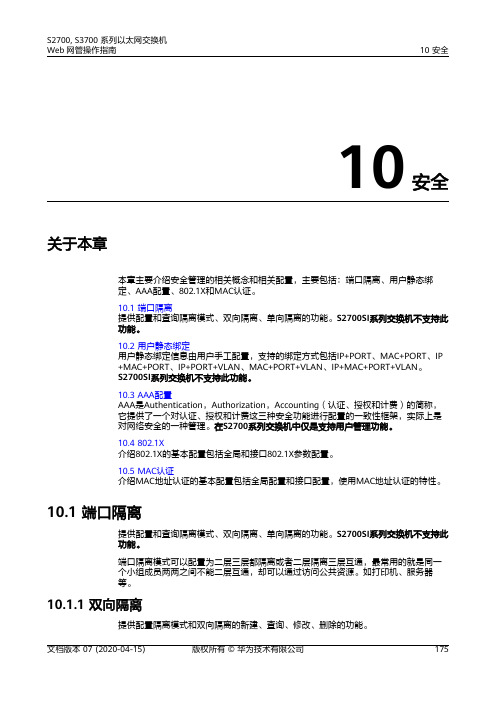
10安全关于本章本章主要介绍安全管理的相关概念和相关配置,主要包括:端口隔离、用户静态绑定、AAA配置、802.1X和MAC认证。
10.1 端口隔离提供配置和查询隔离模式、双向隔离、单向隔离的功能。
S2700SI系列交换机不支持此功能。
10.2 用户静态绑定用户静态绑定信息由用户手工配置,支持的绑定方式包括IP+PORT、MAC+PORT、IP+MAC+PORT、IP+PORT+VLAN、MAC+PORT+VLAN、IP+MAC+PORT+VLAN。
S2700SI系列交换机不支持此功能。
10.3 AAA配置AAA是Authentication,Authorization,Accounting(认证、授权和计费)的简称,它提供了一个对认证、授权和计费这三种安全功能进行配置的一致性框架,实际上是对网络安全的一种管理。
在S2700系列交换机中仅是支持用户管理功能。
10.4 802.1X介绍802.1X的基本配置包括全局和接口802.1X参数配置。
10.5 MAC认证介绍MAC地址认证的基本配置包括全局配置和接口配置,使用MAC地址认证的特性。
10.1 端口隔离提供配置和查询隔离模式、双向隔离、单向隔离的功能。
S2700SI系列交换机不支持此功能。
端口隔离模式可以配置为二层三层都隔离或者二层隔离三层互通,最常用的就是同一个小组成员两两之间不能二层互通,却可以通过访问公共资源。
如打印机、服务器等。
10.1.1 双向隔离提供配置隔离模式和双向隔离的新建、查询、修改、删除的功能。
背景信息●同一端口隔离组的接口之间互相隔离,不同端口隔离组的接口之间不隔离。
●交换机支持64个隔离组,编号为1~64。
操作步骤●配置隔离模式说明●缺省情况下,端口隔离模式为L2(二层隔离三层互通)。
●隔离模式选择应用后,会把双向隔离和单向隔离的配置都应用于该模式。
●切换下方的双向隔离和单向隔离标签不影响隔离模式的配置功能。
●S2700(除S2700-52P-PWR-EI)系列交换机不支持此功能。
S2700S5700系列POE交换机电源供电功率及满供支持最大接口数

S2700/S5700系列POE交换机电源供电功率及满供支持最大接口数PoE设备的电源配置方式PoE交换机的下行电口支持PoE供电。
每端口最大供电功率为30W,最大供电距离100m。
PoE交换机使用信号线耦合供电方式,即在同一对线上同时传输电流和数据。
1、S2750-28TP-PWR-EI-AC、S2750-20TP-PWR-EI-AC和S2751-28TP-PWR-EI-AC均为内置电源2、S2750-28TP-PWR-EI-AC和S2750-20TP-PWR-EI-AC有370W可用于PoE供电,在802.3af协议下最多支持24/16端口PoE满供,在802.3at协议下最多支持12端口PoE满供;2、S2751-28TP-PWR-EI-AC有124W可用于PoE供电,在802.3af协议下最多支持8端口PoE满供,在802.3at协议下最多支持4端口PoE满供。
3、S5700-48TP-PWR-SI、S5700-52C-PWR-EI、S5700-28C-PWR-SI、S5700-52C-PWR-SI、S5700-24TP-PWR-SI和S5700-28C-PWR-EI支持可插拔500W PoE电源和可插拔250W PoE电源。
4、S5710-28C-PWR-EI-AC、S5710-52C-PWR-EI-AC和S5710-52C-PWR-EI支持580W和1150W PoE 电源。
5、S5710-108C-PWR-HI仅支持1150W PoE电源。
电源的搭配关系如下表所示。
电源搭配PoE实际可用功率设备支持接口数(满供)250W –123.2W S5700-48TP-PWR-SIS5700-52C-PWR-EIS5700-28C-PWR-EIS5700-24TP-PWR-SIS5700-28C-PWR-SIS5700-52C-PWR-SI ∙802.3af(15.4W/端口):8∙802.3at(30W/端口):4500W –369.6W S5700-48TP-PWR-SIS5700-52C-PWR-EIS5700-28C-PWR-EIS5700-24TP-PWR-SIS5700-28C-PWR-SIS5700-52C-PWR-SI ∙802.3af(15.4W/端口):24∙802.3at(30W/端口):12250W 250W 246.4W S5700-48TP-PWR-SIS5700-52C-PWR-EIS5700-28C-PWR-EIS5700-24TP-PWR-SIS5700-28C-PWR-SIS5700-52C-PWR-SI ∙802.3af(15.4W/端口):16∙802.3at(30W/端口):8500W 500W 739.2W S5700-48TP-PWR-SIS5700-52C-PWR-EIS5700-52C-PWR-SI ∙802.3af(15.4W/端口):48∙802.3at(30W/端口):24S5700-28C-PWR-EI ∙802.3af(15.4W/端S5700-24TP-PWR-SIS5700-28C-PWR-EIS5700-48TP-PWR-SIS5700-52C-PWR-EIS5700-28C-PWR-SIS5700-52C-PWR-SIS5700-28P-PWR-LI-ACS5700-52P-PWR-LI-ACS5710-28C-PWR-LIS5710-52C-PWR-LIS5700-10P-PWR-LI-ACS5710-28C-PWR-EI-ACS5710-52C-PWR-EI-ACS5710-52C-PWR-EIS5700-28X-PWR-LI-ACS5700-52X-PWR-LI-ACS5710-108C-PWR-HIS3700-28TP-PWR-EIS3700-52P-PWR-EIS3700-28TP-PWR-SIS3700-52P-PWR-SIS2700S2700-26TP-PWR-EIS2700-9TP-PWR-EIS2700-52P-PWR-EIS2710-52P-PWR-SIS2750-20TP-PWR-EI-ACS2750-28TP-PWR-EI-ACS2751-28TP-PWR-EI-AC补充一下2700和3700交换机的支持型号。
华为交换机 01-02 IP路由基础配置
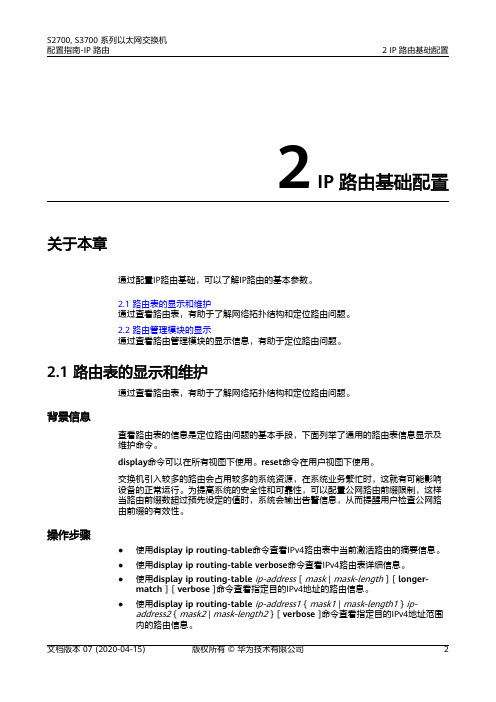
2 IP路由基础配置关于本章通过配置IP路由基础,可以了解IP路由的基本参数。
2.1 路由表的显示和维护通过查看路由表,有助于了解网络拓扑结构和定位路由问题。
2.2 路由管理模块的显示通过查看路由管理模块的显示信息,有助于定位路由问题。
2.1 路由表的显示和维护通过查看路由表,有助于了解网络拓扑结构和定位路由问题。
背景信息查看路由表的信息是定位路由问题的基本手段,下面列举了通用的路由表信息显示及维护命令。
display命令可以在所有视图下使用。
reset命令在用户视图下使用。
交换机引入较多的路由会占用较多的系统资源,在系统业务繁忙时,这就有可能影响设备的正常运行。
为提高系统的安全性和可靠性,可以配置公网路由前缀限制,这样当路由前缀数超过预先设定的值时,系统会输出告警信息,从而提醒用户检查公网路由前缀的有效性。
操作步骤●使用display ip routing-table命令查看IPv4路由表中当前激活路由的摘要信息。
●使用display ip routing-table verbose命令查看IPv4路由表详细信息。
●使用display ip routing-table ip-address [ mask | mask-length ] [ longer-match ] [ verbose ]命令查看指定目的IPv4地址的路由信息。
●使用display ip routing-table ip-address1 { mask1 | mask-length1 } ip-address2 { mask2 | mask-length2 } [ verbose ]命令查看指定目的IPv4地址范围内的路由信息。
●使用display ip routing-table acl { acl-number | acl-name } [ verbose ]命令查看通过指定基本访问控制列表过滤的IPv4路由信息。
●使用display ip routing-table ip-prefix ip-prefix-name [ verbose ]命令查看通过指定前缀列表过滤的IPv4路由信息。
华为S2700接入层交换机参数

Quidway® S2700系列企业网交换机产品概述:Quidway® S2700系列企业网交换机(以下简称S2700)是华为公司推出的新一代绿色节能的以太网智能百兆接入交换机。
它基于新一代交换技术和华为VRP®(Versatile Routing Platform)软件平台,针对企业客户的各种应用场景,提供简单便利的安装维护手段,同时融合了灵活的VLAN部署、完备的安全和QoS控制策略、绿色环保等先进技术,可满足以太网多业务承载和接入需要,助力企业用户搭建面向未来的IT网络。
S2700为盒式产品设备,机箱高度为1U,提供标准型(SI)和增强型(EI)两种产品版本。
产品特性:免维护,易部署,易管理S2700•支持自动配置,智能式即插即用,大大降低初始安装成本;采用全新交换ASIC技术,整机无风扇设计,减少机械故障点的同时免除凝露腐蚀和尘土侵害,能有效降低主机53%维护率。
S2700支持自动批量远程升级,易于使用和部署;友好的Web网管,拓扑自动发现、告警管理、可视化配置,友好的人机界面,简化运维。
此外,还支持HGMPv2、SSHv2、HWTACACS+、RMON、基于端口的流量统计;支持NQA网络质量分析,有利于网络规划和升级。
S2700支持GVRP,实现VLAN动态分发、注册和传播VLAN属性,减少网络管理员的手工配置量、保证VLAN配置正确性,减少因为配置不一致而导致的网络互通问题。
业务控制灵活S2700-EI支持丰富的ACL策略控制,特别支持基于VLAN下发ACL规则,实现VLAN内多端口的灵活控制和统一资源调度。
S2700支持多种VLAN划分方式:支持基于端口划分VLAN,基于MAC地址划分VLAN,可以满足对安全和移动办公需求较高的网络应用场景。
卓越安全,接入舒心S2700支持完备的DHCP Snooping功能,通过侦听接入用户的MAC/IP 地址、租期、VLAN-ID、接口等字段信息,防止IP报文伪造、中间人攻击、DHCP服务器私接等常见企业安全威胁,保障网络接入安全。
- 1、下载文档前请自行甄别文档内容的完整性,平台不提供额外的编辑、内容补充、找答案等附加服务。
- 2、"仅部分预览"的文档,不可在线预览部分如存在完整性等问题,可反馈申请退款(可完整预览的文档不适用该条件!)。
- 3、如文档侵犯您的权益,请联系客服反馈,我们会尽快为您处理(人工客服工作时间:9:00-18:30)。
文档版本 07 (2020-04-15)
版权所有 © 华为技术有限公司
10
S2700, S3700 系列以太网交换机 配置指南-接口管理
参数 接口速率
上报状态变化延时时间 链路振荡保护
2 以太网接口配置
缺省值 自协商模式下,接口的速率是与对端协 商得到的 非自协商模式下,接口的速率为接口支 持的最大速率 上报Up事件延时时间2000毫秒 上报Down事件延时时间0毫秒 未使能
以太网接口是一种用于局域网组网的接口,包括:以太网电接口、以太网光接口。
为了适应网络需求,设备上定义了以下几种以太网接口类型:
● 二层以太网接口:是一种物理接口,工作在数据链路层,不能配置IP地址。它可 以对接收到的报文进行二层交换转发,也可以加入VLAN,通过VLANIF接口对接 收到的报文进行三层路由转发。
2.4 配置端口组
介绍配置端口组以减少重复工作。
背景信息
当用户需要对多个以太网接口进行相同的配置时,可以将这多个以太网接口加入端口 组内。在端口组视图下,用户只需输入一次配置命令,该端口组内的所有以太网接口 都会配置该功能,完成接口批量配置,减少重复配置工作。
S2700, S3700 系列以太网交换机 配置指南-接口管理
2 以太网接口配置
2 以太网接口配置
关于本章
以太网以其高度灵活、相对简单、易于实现的特点,成为重要的局域网组网技术。当 您选择以太网进行局域网组网时,可以使用以太网接口。
2.1 规格
2.2 以太网接口简介 以太网接口是一种用于局域网组网的接口,包括:以太网电接口、以太网光接口。
端口组
S2700, S3700支持的端口组功能主要是为了方便用户同时对端口组中的多个接口进行 配置。在端口组视图下,用户只需输入一次配置命令,则该端口组内的所有接口都会 配置该功能,以减少重复配置工作。
自协商
自协商的主要功能就是使物理链路两端的接口通过协商能力信息交互来自动选择同样 的工作参数。自协商接口发送本端的协商能力信息并检测对端的信息。一旦本端收到 对端的协商能力信息,并且得知对端也收到本端发送的协商信息,就比较两端的能力 来建立起双方具有的最高性能的工作模式。
端口隔离功能为用户提供了更安全、更灵活的组网方案。
2.3 缺省配置
介绍以太网接口常见参数的缺省配置。
表 2-2 以太网接口缺省配置
参数 Combo接口工作模式 MDI(Media Dependent Interface)类 型 双工模式
缺省值 Auto,即自动切换光口模式与电口模式 Auto,即自动识别所连接网线的类型
2 以太网接口配置
表 2-1 以太网接口属性
接口类型
速率
双工模式
(Mbit/s)
百兆以太网 10
FE(Fast
Ethernet)
电接口
100
全双工/半 双工
全双工/半 双工
千兆以太网
GE (Gigabit Ethernet) 电接口
10 100 1000
全双工/半 双工
全双工/半 双工
全双工
FE光接口 100
2.3 缺省配置 介绍以太网接口常见参数的缺省配置。
2.4 配置端口组 介绍配置端口组以减少重复工作。
2.5 配置以太网接口 介绍配置以太网接口的速率、自协商功能、网线类型、双工模式、光接口与电接口切 换等功能的过程与步骤。
2.6 维护以太网接口 维护以太网接口,包括通过环回功能检测接口转发是否正常、清除接口统计信息。
用户可以开启以太网接口环回测试功能,检验以太网接口能否正常工作。测试时接口 将不能正常转发数据包。S2700, S3700支持内部环回测试模式,该测试模式在PHY芯 片内部建立自环,接口设置为该模式后,会产生一定数量的测试报文,这些报文通过 PHY芯片内部建立的自环又返回到该接口。该功能用以定位芯片内与该接口相关的模 块是否出现故障。
全双工
GE光接口 100
全双工
1000
全双工
自协商模式 流量控制
支持
支持
支持
支持
不支持 支持 支持
支持 支持 支持
流量控制自 协商 支持
支持
不支持 不支持 支持
说明
缺省情况下,以太网接口工作在自协商模式。推荐使用缺省值。一旦协商成功,链路两端的设备 就锁定在同样的双工模式和运行速率。
2.2 以太网接口简介
为了实现报文之间的二层隔离,可以将不同的接口加入不同的VLAN,但会浪费有限的 VLAN资源。
采用端口隔离特性,可以实现同一VLAN内接口之间的隔离。用户只需要将接口加入到 隔离组中,就可以实现隔离组内接口之间二层数据的隔离。这种隔离是双向的,即若 将接口A和B加入同一个隔离组,则从接口A发送的二层报文不能到达接口B,从接口B 发送的报文也不能到达接口A。
电缆检测 接口环回 端口st)功能可用于检测接口所连的电缆是否存在故障。 当电缆状态正常时,显示该电缆的总长度;当电缆状态非正常时,显示电缆的故障类 型,并且能够给出故障点的位置,便于定位和解决网线问题。 VCT一般用于在链路出 现故障时,检测是否因电缆故障导致的。由于电缆检测会导致业务的短暂中断,所以 不建议用户在业务正常运行时使用。
自动协商的内容主要包括运行速率和流控参数。一旦协商通过,链路两端的接口就以 同样的运行速率和流控参数来工作。
文档版本 07 (2020-04-15)
版权所有 © 华为技术有限公司
9
S2700, S3700 系列以太网交换机 配置指南-接口管理
2 以太网接口配置
流量控制
当本端和对端设备都开启了流量控制功能后,如果本端设备发生拥塞,它将向对端设 备发送消息,通知对端设备暂时停止发送报文;而对端设备在接收到该消息后将暂时 停止向本端发送报文,从而避免了报文丢失现象的发生。
2.7 配置举例 介绍以太网接口的配置举例。配置举例包括组网需求、配置思路、操作步骤等,并提 供配置文件。
2.8 常见配置错误 介绍配置过程中常见的配置错误。
2.1 规格
以太网接口的属性如表2-1所示。
文档版本 07 (2020-04-15)
版权所有 © 华为技术有限公司
8
S2700, S3700 系列以太网交换机 配置指南-接口管理
